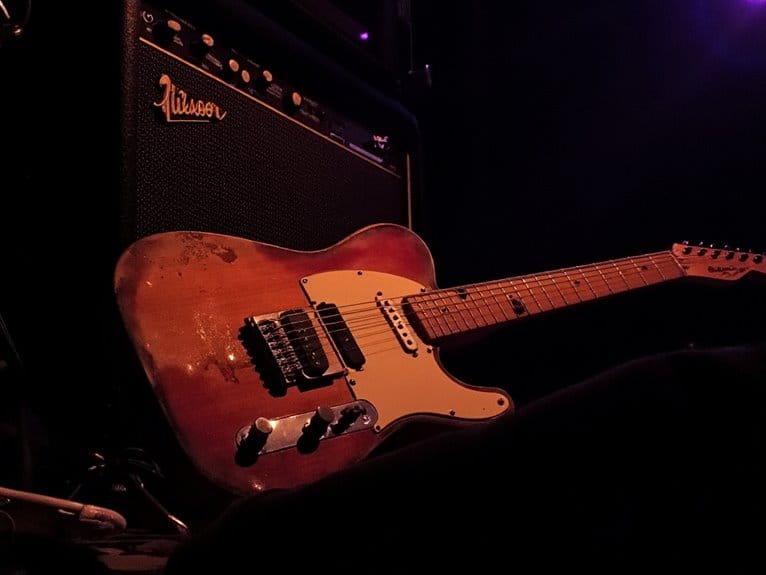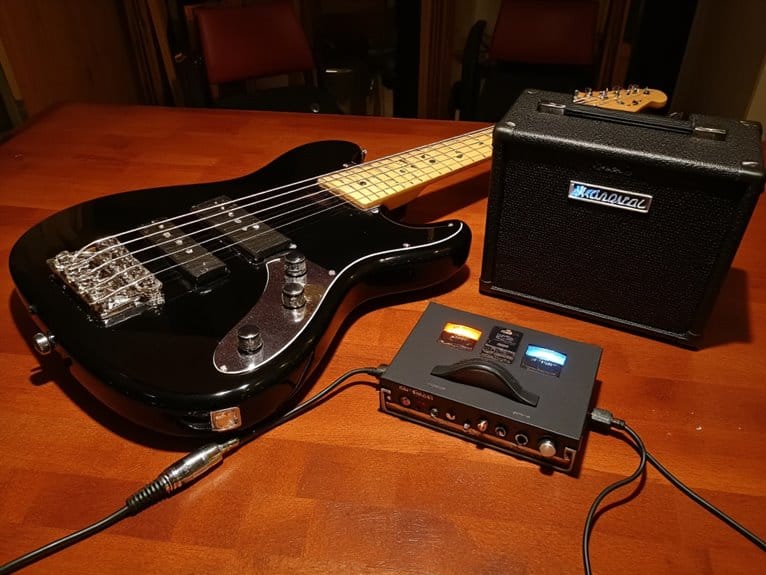Rhythm Guitar: The Unsung Hero of Great Songs
You’ll find rhythm guitar serves as music’s structural backbone, creating harmonic frameworks through chord progressions while locking rhythmic pulse with drums and bass. I’ve observed how it supports lead guitars and vocals, preventing disconnection through techniques like syncopated rhythms, attack dynamics, and strategic use of pauses. Whether you’re playing metal’s palm-muted downpicking or folk’s arpeggiated patterns, rhythm guitar shapes song structure, manages harmonic tension, and provides the foundation that transforms good songs into unforgettable anthems-and there’s much more beneath this essential craft.
We are supported by our audience. When you purchase through links on our site, we may earn an affiliate commission, at no extra cost for you. Learn more.
Notable Insights
- Rhythm guitar provides the essential harmonic framework and structural backbone that holds all musical elements together in great songs.
- Creates recognizable patterns and distinct strumming techniques that signal song sections and guide listeners through emotional transitions.
- Supports lead instruments and vocals by providing solid chordal foundations while using techniques like palm muting to create space.
- Adapts seamlessly across genres using specialized techniques like metal’s palm-muted downpicking or funk’s syncopated muting for percussive grooves.
- Locks in with drums and bass to establish the rhythmic pulse that drives songs forward and keeps listeners engaged.
The Foundation That Holds Everything Together
Music, much like architecture, relies on an invisible yet crucial foundation that determines whether the entire structure stands or collapses. In the world of contemporary music, rhythm guitar serves as that fundamental structural element.
When you’re playing rhythm guitar, you’re not just strumming chords-you’re creating the bedrock that allows everything else to flourish. Your chord progressions provide the harmonic framework while your rhythmic pulse locks in with the drums and bass, creating an unshakeable foundation.
Without this steady backbone, lead guitars would sound disconnected, vocals would lack support, and the entire band would risk falling apart. You’re fundamentally the glue that binds all musical elements together, maintaining both timing and harmonic structure.
Essential Techniques That Drive the Music Forward
Three fundamental techniques form the backbone of effective rhythm guitar playing, and I’ve found that mastering these core elements will transform your ability to drive music forward with confidence and precision.
First, developing syncopated rhythms through strategic off-beat emphasis creates dynamic tension that keeps listeners engaged, while straightforward on-beat patterns provide essential release and resolution.
Syncopated off-beat emphasis builds tension while on-beat patterns provide resolution, creating the push-and-pull dynamic that captivates listeners.
Second, crafting rhythmic motifs with subtle variations in note duration and pitch maintains cohesiveness while preventing monotony-I’ve discovered this balance requires patience to develop properly. Understanding the balance between functionality and portability mirrors how professional audio engineers select equipment, ensuring your rhythm guitar setup delivers consistent performance whether you’re playing intimate coffee shop gigs or commanding larger venue stages.
Third, employing deliberate attack dynamics and strumming variations individualizes your rhythm parts, transforming simple chord progressions into compelling musical foundations.
These techniques, when combined with strategic use of pauses and rests, create the rhythmic framework that supports every other element in your songs. Just as professional recording setups prioritize noise reduction to achieve crystal-clear audio quality, rhythm guitarists must eliminate unnecessary string noise and maintain clean technique to ensure their foundational patterns cut through the mix effectively. Incorporating a looper pedal can further enhance your rhythmic foundation by allowing you to layer multiple patterns, creating a richer soundscape. This tool not only aids in practice by helping you hear how different elements interact, but it also opens up opportunities for live performance, where you can build complex arrangements on the fly. By mastering both your technique and the use of tools like a looper pedal, you can elevate your guitar playing to new heights, engaging listeners with dynamic and immersive music.
How Rhythm Guitar Shapes Song Structure and Flow
Understanding how rhythm guitar shapes song structure reveals its role as the architectural blueprint that determines how listeners experience musical flow. I’ve observed that this foundational element operates much like a building’s framework-invisible yet essential for everything else to function properly.
Your chord progressions establish the harmonic roadmap that guides each section’s emotional tone, while rhythmic motifs create recognizable patterns that signal shifts between verses and choruses.
The dynamic interplay between rhythm guitar and other instruments manifests through several key mechanisms:
- Establishing distinct strumming patterns for different song sections
- Creating harmonic tension and release through chord choice timing
- Maintaining consistent pulse while allowing subtle groove variations
- Framing lead guitar solos with solid chordal foundations
- Using rhythmic density changes to build or reduce energy
This structural foundation determines whether your song feels cohesive or fragmented to listeners.
Adapting to Different Musical Styles and Settings
| Genre | Primary Technique | Characteristic Sound |
|---|---|---|
| Metal | Palm-muted downpicking | Tight, chunky rhythms |
| Funk | Syncopated muting | Percussive grooves |
| Folk | Arpeggiated patterns | Bright, melodic flow |
| Blues | Open chord strumming | Warm, resonant feel |
Different instruments enhance this adaptability-twelve-string guitars deliver jangly brightness for folk, while overdriven electrics provide the crunch essential for rock’s driving power. Acoustic basses add depth to the overall sound, enriching the harmonic foundations in any ensemble. Furthermore, vintage guitars debunking common myths prove that age does not always equate to value; sometimes, the most unassuming instruments can produce the most extraordinary tones, captivating audiences in unexpected ways. Each instrument plays a unique role, blending seamlessly and allowing for an expansive range of musical expression.
The Art of Supporting Without Overpowering
While lead guitarists command attention with soaring solos and flashy techniques, I’ve learned that rhythm guitar’s true mastery lies in knowing when to step back, creating a musical foundation so solid that others can shine without even realizing you’re there.
The secret involves maintaining dynamic tension through precise timing while employing subtle complexity that enhances rather than competes.
You’ll need to develop these essential supporting techniques:
- Use palm muting and softer strumming during vocal lines to create space
- Select chord voicings that complement bass frequencies without cluttering
- Practice tasteful “comping” with syncopated punctuations rather than constant strumming
- Alternate between full chords and sparse rhythmic hits for textural contrast
- Synchronize with drum patterns to create interlocking rhythms without crowding
This restraint requires more discipline than flashy solos, but when executed properly, you become the invisible backbone that makes everyone else sound incredible.
On a final note
You’ve now seen how rhythm guitar forms the backbone of countless memorable tracks, providing harmonic foundation while driving songs forward through careful timing and technique. Whether you’re strumming power chords in a rock anthem or fingerpicking intricate patterns in folk arrangements, your role as rhythm guitarist demands both technical precision and musical restraint. Master these fundamentals, and you’ll discover that supporting the song often creates more impact than any flashy solo ever could.






